From San Diego, CA, to Brownsville, TX, more than 650 miles of border walls and barriers have fractured communities and drastically altered the lives of countless individuals. The following profiles tell some of the stories that you haven't heard. They introduce you to individuals and families impacted by the wall and separated from their land.
Dr. Eloisa Tamez
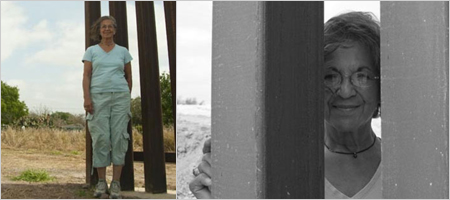
For Eloisa Tamez the land is sacred. She is a 74 year old descendant of Lipan Apache and Basque and it was on this very land in South Texas that 15 generations of her family lived and died. In 1767, King Charles III of Spain granted her ancestors the land that is now known as the community of El Calaboz where some 20 families still live.
Eloisa served in the US Army Nurse Corps and over her long service achieved the rank of Lt. Colonel. She then became a professor at the University of Texas Brownsville and Texas Southmost College, and also a Commander of the Texas Medical Brigade of the Texas National Guard. She has served her country and preserved her family's long history on the land. But now her country has built walls through the lifeblood of her family heritage.
In 2008, Secretary of the Department of Homeland Security, Michael Chertoff demanded Eloisa sign over her land or be sued by the federal government: a large portion of her land would be condemned through eminent domain. She refused, fought back and became a symbol of resistance against the wall when she filed suit against Chertoff and the DHS.
In April of 2009, a district court said DHS had the power to build through eminent domain, but the court required DHS to consult with Dr. Tamez about how construction would proceed. DHS ignored this court order, and within 48 hours, the US government built 18 feet of steel wall across her land, leaving her limited access to the southern portion along the Rio Grande River, the river that drew her family here more than 200 years ago.
Christian Ramirez and Family
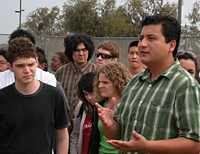 Christian Ramirez and his family have lived and worked in the San Diego/Tijuana border region for three generations. Christian's grandfather and grandmother came to San Diego as guest workers in the 1950s, and Christian's father became a legal resident of the U.S. as a child and later moved his family to nearby San Ysidro, California.
Christian Ramirez and his family have lived and worked in the San Diego/Tijuana border region for three generations. Christian's grandfather and grandmother came to San Diego as guest workers in the 1950s, and Christian's father became a legal resident of the U.S. as a child and later moved his family to nearby San Ysidro, California.
Like hundreds of children of Mexican-American families, Christian spent weekends in Tijuana with extended family, playing with cousins and friends on both sides of the border. Christian became conscious of the internation border only when he became a citizen at age 10. While awaiting finalization of citizenship status, Christian couldn't legally leave San Diego, and Friendship Park became the only place where Christian could go to spend time with family in Mexico.
"That's when I realized just how real the border was — when I realized that we couldn't go back and forth anymore. It was pretty traumatic," Christian recalls.
Friendship Park is still a special gathering place for families separated by the international border, but increased enforcement and construction of a double-layer border wall has all but eliminated public access to Friendship Park.
Christian now works with a coalition of over 40 San Diego community organizations calling for the restoration of Public Access to Friendship Park, and the Southern Border Communities Coalition, a border-wide effort to protect the rights of those who live in the borderlands.
Ofelia Rivas and the O'Odham
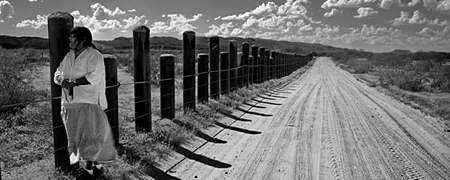
Ofelia Rivas' people, the O'odham, have lived in the Sonoran Desert for thousands of generations, freely traveling to communities throughout their territory, which radiates outward from Baboquivari, the sacred mountain of the O'odham. Conflicts between other nations have throughout history affected the lives of the O'odham, and today is no different.
Ofelia lives in Ali Jegk village in southern Arizona, less than a quarter mile from the United States/Mexico international border. The Tohono O'odham Nation shares 74 miles of international border with Mexico, but the tribe's traditional lands span both sides of the line.
The border wall represents a massive scar through the heart of O'odham lands, which cover a vast area on both sides of the border. Now Ofelia's people must cross a militarized border to visit sacred sites, to conduct ceremonies and to visit each other. Treated as suspects in their own lands, Tohono O'odham are often delayed, prevented from crossing, or subjected to harassment, detention, confiscation of papers, and even violence.
Noel Benavidez and Family
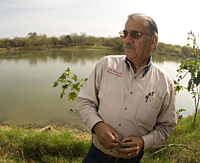 Noel Benavidez' family has lived on the northern bank of the Rio Grande in South Texas since the family received a Spanish land grant two hundred years ago.
Noel Benavidez' family has lived on the northern bank of the Rio Grande in South Texas since the family received a Spanish land grant two hundred years ago.
Every year for many generations his family, which is now spread throughout the US and Mexico, meets on the bank of the river for a family reunion. Noel's beloved granddaughter marks the tenth generation of the Benavidez family on this land.
If the Department of Homeland Security continues to build the remaining miles of wall it plans for South Texas, Noel's family reunion grounds, the Rio Grande, and one third of his property will be blocked from him by the wall.
Valer and Joe Austin
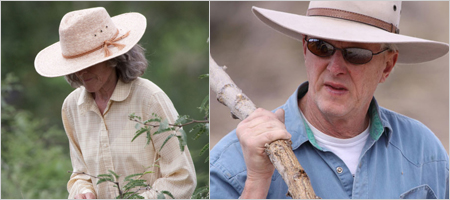
Valer and Joe Austin own and work to restore land in southeastern Arizona, northern Mexico, and Texas. Border infrastructure has already impacted the Austins' land in northern Mexico, and if the policy of the wall continues, could affect their land in Texas.
The Austins have been working for many years to purchase conservation properties in the borderlands and restore health to their lands' watersheds, grasslands and wildlife.
Their work has greatly complemented and advanced the efforts of state and federal government programs to restore habitat connectivity and revive struggling wildlife populations in the Southwest. In a time of global warming, their work to create free passage for animal migrations has never been more important to myriad species like black bear, mule deer, and mountain lions.
Their tremendous commitment to the land and wildlife of North America is now at the mercy of border and immigration policies-especially the construction of border barriers and roads through land that the Austins own and manage for the primary purpose of wildlife restoration and migration.
Smoking Joe Martinez
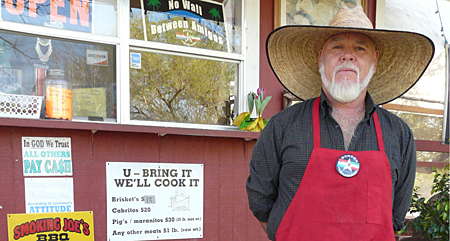
Jose Martinez III, whose classic presence and countenance are instantly etched into one's mind, is the third generation of his family to live on the Rio Grande. His home, land and business are on the south side of Highway 281 in the southern reaches of Mercedes, Texas. He shares the land with his aunt, who lives in a home near the river.
It is on this land that Joe derives his sole livelihood from well known Smoking Joe's BBQ, one of the most popular in the Rio Grande Valley and a place known for its kindness to strangers and those without means to pay for food. His BBQ stand sits on the banks of a "Resaca," an old river channel abandoned by the Rio Grande.
Joe's home and famous BBQ are flanked by border wall on both sides of his property. The wall is built right through his property, along the levy his grandfather helped build. This concrete wall separates him from the Rio Grande and the home of his aunt and cousin, which are on the Mexican side of the wall.
Rev. John Fanestil and Friendship Park
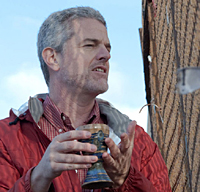 For generations, Mexican-American families of San Diego/Tijuana divided by the international boundary have gathered on Sunday afternoons on both sides of the border fence at Friendship Park.
For generations, Mexican-American families of San Diego/Tijuana divided by the international boundary have gathered on Sunday afternoons on both sides of the border fence at Friendship Park.
Friendship Park was dedicated in 1971 by then First Lady Pat Nixon as a symbol of binational friendship. A California State Park overlooking the Pacific Ocean, it was an appropriate and stunningly beautiful setting where grandmothers, sons, daughters and grandchildren living in the U.S. and Mexico could meet. Through the barbed wire or chain link fence, they could share a simple Sunday meal of homemade tamales, empanadas or pan dulce.
Then the Department of Homeland Security turned its focus on Friendship Park as a theatre of law enforcement operations, and it declared that passing simple foods through the fence was a customs violation. A wall was constructed, then another parallel wall, making it all but impossible for families to meet or touch at Friendship Park.
Rev. John Fanestil responded by joining these families each Sunday, breaking bread together by sharing Holy Communion with worshippers on both sides of the border fence, a symbol of binational solidarity and friendship in keeping with the park's original purpose. He has worked with the Friends of Friendship Park to try to negotiate public access to this historically and socially important spot.
For the latest status of Friendship Park, check http://www.friendshippark.org/
Dan Millis and Josseline

Dan Millis, born and raised in Arizona, has a daily connection to some of the cruelest realities of our border policy. While hiking along a canyon just north of the Arizona/Mexico border with a group of volunteers from border humanitarian aid group No More Deaths, Dan stumbled across the corpse of a girl. At only 14, the Salvadoran girl Josseline was the youngest of the 183 recovered bodies along the Arizona border in 2008.
Thousands of migrants have died along the U.S. border since the mid 1990s, when border walls and increased enforcement began to funnel them into remote and dangerous terrain. His experiences in the borderlands have led him to dedicate his working life to the human and environmental costs of bad border policy. He works for the Sierra Club Grand Canyon Chapter's Borderlands program.
Two days after finding Josseline in the desert, Dan was distributing water jugs along migrant trails near the border. He was stopped by federal authorities and issued a citation. The ticket was written for "littering," despite the boxes full of trash that he and a group of No More Deaths volunteers had been cleaning up from the area. Dan refused to pay the ticket, and was later convicted in federal court. After a year and a half of legal battles, the Ninth Circuit Court of Appeals reversed the lower courts' decisions, and Dan's "littering" conviction was overturned!
Thanks to Krista Schlyer (enviro-pic.org) for creating the Faces of the Borderlands and for photos donated by ilcp.com.